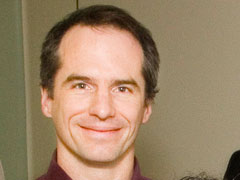Checking it Out
By Laura Pratt
It's a supermarket mentality for a hospital setting.
Dr. Ed Etchells, director of patient safety improvement research with the Centre for Health Services Sciences at Sunnybrook Health Sciences Centre, has a solution for reducing medication error: throw a bar code on everything and let technology work it out.
Medication error is a worrying phenomenon. For every 100 medication errors, patients suffer seven "close calls" (where they're spared any injury thanks to either luck or resilience) and one incidence of harm.
Drug administration errors are a function of a failing in one of the "five rights" required of effective dispensation: right patient, route, rate, dose and frequency. "If the health professional makes a [mistake]," says Etchells, "there's no line of defense. The only person who might notice it is the patient—and it may be too late."
A system that features bar codes would have these miraculous little optical machine-readable data marks applied to all critical points along the line: patient, nurse, drug. A nurse looking to administer medicine to a patient would use a portable wand to scan first herself, then the drug and then the patient. All of the information would wend its electronic way to a central prescribing system as a further check that the medication was, in fact, prescribed for that person, and that it doesn't interact with any of the results from the patient's latest lab work.
Introducing these systems to a health care setting, says Etchells, who wrote a commentary on this subject for the Journal of the American Medical Association last May "just for fun," can reduce medication administration errors by between 54% and 86%.
"The view is that the humans are only as good as the systems in which they work," says Etchells, who is also the medical director for information services at Sunnybrook and an associate professor in the faculty of medicine at the University of Toronto. "The current system is designed to allow these errors to occur and, more importantly, to let them go unrecognized in almost all cases."
The challenge, he says, is to implement systematic techniques with the introduction of a safeguarding step between nurse and patient. Nurses (who commonly administer medications) don't have any systematic safeguard in place to catch expected human error, whereas physicians (who commonly prescribe medications) benefit from many systematic safeguards— clinical pharmacists, nurses and computer systems among them—that capture expected human error.
In any event, the barcoding solution is not foolproof. Not every medication can be given a bar code, for example. Sometimes, patients' barcoding bracelets get wet and are rendered unreadable. The portable bar-code readers are not yet powered with sufficient battery life. And there are problems emerging with the wand's ability to read on curved surfaces, like wrists. The technology, says Etchells, is a work in progress.
Barcoding first surfaced as a health care application about a decade ago. Today, cost and the vastness of the system overhauls required keep widespread implementation at bay. Although there are scatterings of different applications already live in the system (Sunnybrook is involved with the barcoding of blood products in-house and the barcoding of breast milk at Women's College Hospital's neonatal intensive care unit), only about 9% of American hospitals use bar codes.
"It's a massive primary-system change, Etchells says. "It has to be bulletproof; otherwise, you've got big problems."
Still, he's hopeful. "It's inevitable," he says, of the eventual rollout of barcoding systems to health care centres. "There's no other systematic method for reducing drug administration error. In a perfect world, in five years all big hospitals will have them, although I recognize that's unrealistic. I just hope they're in place before I'm old and sick."
PDF / View full media release »


